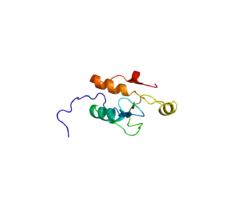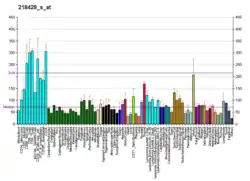| REV1 | |||||||||||||||||||||||||||||||||||||||||||||||||||
|---|---|---|---|---|---|---|---|---|---|---|---|---|---|---|---|---|---|---|---|---|---|---|---|---|---|---|---|---|---|---|---|---|---|---|---|---|---|---|---|---|---|---|---|---|---|---|---|---|---|---|---|
 | |||||||||||||||||||||||||||||||||||||||||||||||||||
| |||||||||||||||||||||||||||||||||||||||||||||||||||
| Identifiers | |||||||||||||||||||||||||||||||||||||||||||||||||||
| Aliases | REV1, REV1L, AIBP80, DNA directed polymerase, REV1 DNA directed polymerase | ||||||||||||||||||||||||||||||||||||||||||||||||||
| External IDs | OMIM: 606134 MGI: 1929074 HomoloGene: 32309 GeneCards: REV1 | ||||||||||||||||||||||||||||||||||||||||||||||||||
| |||||||||||||||||||||||||||||||||||||||||||||||||||
| |||||||||||||||||||||||||||||||||||||||||||||||||||
| |||||||||||||||||||||||||||||||||||||||||||||||||||
| |||||||||||||||||||||||||||||||||||||||||||||||||||
| |||||||||||||||||||||||||||||||||||||||||||||||||||
| Wikidata | |||||||||||||||||||||||||||||||||||||||||||||||||||
| |||||||||||||||||||||||||||||||||||||||||||||||||||
DNA repair protein REV1 is a protein that in humans is encoded by the REV1 gene.[5][6]
This gene encodes a protein with similarity to the S. cerevisiae mutagenesis protein Rev1. The Rev1 proteins contain a BRCT domain, which is important in protein-protein interactions. A suggested role for the human Rev1-like protein is as a scaffold that recruits DNA polymerases involved in translesion synthesis (TLS) of damaged DNA. Two alternatively spliced transcript variants that encode different proteins have been found.[6]
Rev1 is a Y family DNA polymerase; it is sometimes referred to as a deoxycytidyl transferase because it only inserts deoxycytidine (dC) across from lesions. Whether G, A, T, C, or an abasic site, Rev1 will always add a C. Rev1 has the ability to always add a C, because it uses an arginine as a template which complements well with C.[7] Yet it is believed that Rev1 rarely uses its polymerase activity; rather it is thought that Rev1's primary role is as a protein landing pad, whereby it helps direct the recruitment of TLS proteins, especially Pol ζ (Rev3/Rev7).
Interactions
REV1 has been shown to interact with MAD2L2.[8] It is believed that Rev1 may interact with PCNA, once ubiquitylated due to a lesion, and help recruit Pol ζ (Rev3/Rev7) a B family polymerase involved in TLS.
References
- 1 2 3 GRCh38: Ensembl release 89: ENSG00000135945 - Ensembl, May 2017
- 1 2 3 GRCm38: Ensembl release 89: ENSMUSG00000026082 - Ensembl, May 2017
- ↑ "Human PubMed Reference:". National Center for Biotechnology Information, U.S. National Library of Medicine.
- ↑ "Mouse PubMed Reference:". National Center for Biotechnology Information, U.S. National Library of Medicine.
- ↑ Lin W, Xin H, Zhang Y, Wu X, Yuan F, Wang Z (Dec 1999). "The human REV1 gene codes for a DNA template-dependent dCMP transferase". Nucleic Acids Res. 27 (22): 4468–75. doi:10.1093/nar/27.22.4468. PMC 148731. PMID 10536157.
- 1 2 "Entrez Gene: REV1 REV1 homolog (S. cerevisiae)".
- ↑ Nair, DT (Sep 30, 2005). "Rev1 employs a novel mechanism of DNA synthesis using a protein template". Science. 309 (5744): 2219–22. Bibcode:2005Sci...309.2219N. doi:10.1126/science.1116336. PMID 16195463. S2CID 35378034.
- ↑ Murakumo, Y; Ogura Y; Ishii H; Numata S; Ichihara M; Croce C M; Fishel R; Takahashi M (September 2001). "Interactions in the error-prone postreplication repair proteins hREV1, hREV3, and hREV7". J. Biol. Chem. United States. 276 (38): 35644–51. doi:10.1074/jbc.M102051200. ISSN 0021-9258. PMID 11485998.
Further reading
- Bonaldo MF, Lennon G, Soares MB (1997). "Normalization and subtraction: two approaches to facilitate gene discovery". Genome Res. 6 (9): 791–806. doi:10.1101/gr.6.9.791. PMID 8889548.
- Wixler V, Laplantine E, Geerts D, et al. (1999). "Identification of novel interaction partners for the conserved membrane proximal region of alpha-integrin cytoplasmic domains". FEBS Lett. 445 (2–3): 351–5. doi:10.1016/S0014-5793(99)00151-9. PMID 10094488. S2CID 9218762.
- Gibbs PE, Wang XD, Li Z, et al. (2000). "The function of the human homolog of Saccharomyces cerevisiae REV1 is required for mutagenesis induced by UV light". Proc. Natl. Acad. Sci. U.S.A. 97 (8): 4186–91. Bibcode:2000PNAS...97.4186G. doi:10.1073/pnas.97.8.4186. PMC 18191. PMID 10760286.
- Wixler V, Geerts D, Laplantine E, et al. (2000). "The LIM-only protein DRAL/FHL2 binds to the cytoplasmic domain of several alpha and beta integrin chains and is recruited to adhesion complexes". J. Biol. Chem. 275 (43): 33669–78. doi:10.1074/jbc.M002519200. PMID 10906324.
- Masuda Y, Takahashi M, Tsunekuni N, et al. (2001). "Deoxycytidyl transferase activity of the human REV1 protein is closely associated with the conserved polymerase domain". J. Biol. Chem. 276 (18): 15051–8. doi:10.1074/jbc.M008082200. PMID 11278384.
- Murakumo Y, Ogura Y, Ishii H, et al. (2001). "Interactions in the error-prone postreplication repair proteins hREV1, hREV3, and hREV7". J. Biol. Chem. 276 (38): 35644–51. doi:10.1074/jbc.M102051200. PMID 11485998.
- Strausberg RL, Feingold EA, Grouse LH, et al. (2003). "Generation and initial analysis of more than 15,000 full-length human and mouse cDNA sequences". Proc. Natl. Acad. Sci. U.S.A. 99 (26): 16899–903. Bibcode:2002PNAS...9916899M. doi:10.1073/pnas.242603899. PMC 139241. PMID 12477932.
- Masuda Y, Ohmae M, Masuda K, Kamiya K (2003). "Structure and enzymatic properties of a stable complex of the human REV1 and REV7 proteins". J. Biol. Chem. 278 (14): 12356–60. doi:10.1074/jbc.M211765200. PMID 12529368.
- Clark DR, Zacharias W, Panaitescu L, McGregor WG (2004). "Ribozyme-mediated REV1 inhibition reduces the frequency of UV-induced mutations in the human HPRT gene". Nucleic Acids Res. 31 (17): 4981–8. doi:10.1093/nar/gkg725. PMC 212819. PMID 12930947.
- Guo C, Fischhaber PL, Luk-Paszyc MJ, et al. (2004). "Mouse Rev1 protein interacts with multiple DNA polymerases involved in translesion DNA synthesis". EMBO J. 22 (24): 6621–30. doi:10.1093/emboj/cdg626. PMC 291821. PMID 14657033.
- Ota T, Suzuki Y, Nishikawa T, et al. (2004). "Complete sequencing and characterization of 21,243 full-length human cDNAs". Nat. Genet. 36 (1): 40–5. doi:10.1038/ng1285. PMID 14702039.
- Ohashi E, Murakumo Y, Kanjo N, et al. (2005). "Interaction of hREV1 with three human Y-family DNA polymerases". Genes Cells. 9 (6): 523–31. doi:10.1111/j.1356-9597.2004.00747.x. PMID 15189446. S2CID 24470762.
- Tissier A, Kannouche P, Reck MP, et al. (2005). "Co-localization in replication foci and interaction of human Y-family members, DNA polymerase pol eta and REVl protein". DNA Repair (Amst.). 3 (11): 1503–14. doi:10.1016/j.dnarep.2004.06.015. PMID 15380106.
- Hillier LW, Graves TA, Fulton RS, et al. (2005). "Generation and annotation of the DNA sequences of human chromosomes 2 and 4". Nature. 434 (7034): 724–31. Bibcode:2005Natur.434..724H. doi:10.1038/nature03466. PMID 15815621.
- Lin X, Okuda T, Trang J, Howell SB (2006). "Human REV1 modulates the cytotoxicity and mutagenicity of cisplatin in human ovarian carcinoma cells". Mol. Pharmacol. 69 (5): 1748–54. doi:10.1124/mol.105.020446. PMID 16495473. S2CID 22316155.
- Masuda Y, Kamiya K (2006). "Role of single-stranded DNA in targeting REV1 to primer termini". J. Biol. Chem. 281 (34): 24314–21. doi:10.1074/jbc.M602967200. PMID 16803901.
- Yuasa MS, Masutani C, Hirano A, et al. (2006). "A human DNA polymerase eta complex containing Rad18, Rad6 and Rev1; proteomic analysis and targeting of the complex to the chromatin-bound fraction of cells undergoing replication fork arrest". Genes Cells. 11 (7): 731–44. doi:10.1111/j.1365-2443.2006.00974.x. PMID 16824193. S2CID 32695133.




